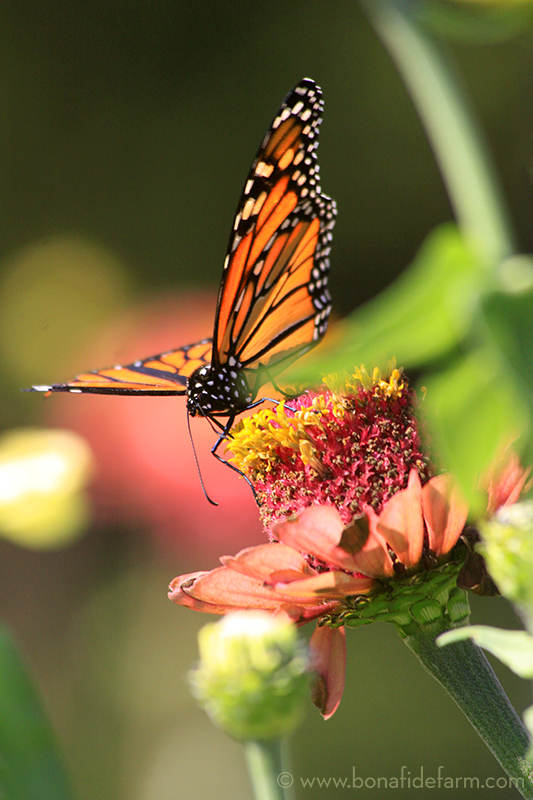I found this lone monarch feasting amongst the zinnas last week. Given all the trouble monarchs are in, I was very happy to see it and to know I’d done my part to cultivate a delicious banquet of nectar-rich flowers. I wonder if this butterfly was refueling on its migration to Mexico?
Monarch butterflies are decreasing at an alarming rate: 59% in the last year according to a survey carried out during the 2012-2013 winter season by the WWF-Telcel Alliance, and Mexico’s National Commission of Protected Areas (CONAP). The numbers of monarchs are at their lowest numbers in 20 years. According to the same organization:
The latest decrease in monarch butterflies is likely due to a decrease in the milkweed plant (Asclepias) – a primary food for monarchs – from herbicide use in the butterfly’s reproductive and feeding grounds in the US, as well as extreme climate variations during the fall and summer affecting butterfly reproduction.
Why should you care if monarch numbers are decreasing? Because monarchs, like all insects, are pollinators. In simplest terms, without pollinators we won’t have any of the foods that require pollination, no fruits or vegetables, and these are the healthiest foods we can eat. And even a food that doesn’t appear to be a vegetable, such as bread, starts life as a plant that probably needs to be pollinated.
So if we want to keep eating, we have to cultivate what pollinators need to thrive and eliminate the use of what’s killing them—pesticides and herbicides. In the case of the monarch, their most important food is milkweed. There are some native milkweeds in this area, and one of the reasons I don’t mow some of my fields is to let these “weeds” flower to feed the monarchs. Even so, these butterflies need more milkweed. It’s one of my goals to some day make a formal monarch garden, rich with milkweeds, to try to encourage monarchs to breed and cocoon right here.
If you’ve never seen a monarch cocoon in person, it’s worth planting a butterfly garden just for a chance to spy this treat. The cocoons are the most beautiful color of Jadeite green and are decorated with spots of pure, shining gold. They look like precious jewels. When the monarch is about to hatch, the cocoon turns translucent and you can see the orange and black butterfly folded up inside. When it emerges, it’s all wet, sticky and deflated, and it must sit and slowly pump its wings until its blood inflates them. Truly fascinating and beautiful to watch in person.
For even more on the monarchs, visit monarchwatch.org. And for a scientifically literary take on the monarchs’ plight, read Flight Behavior, by Barbara Kingsolver, one of my most favorite authors.

